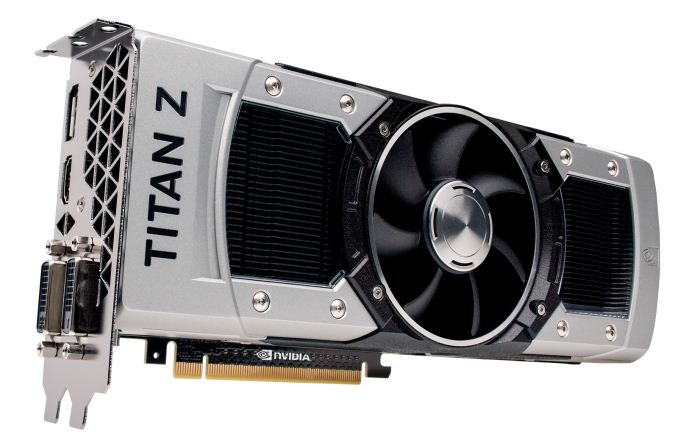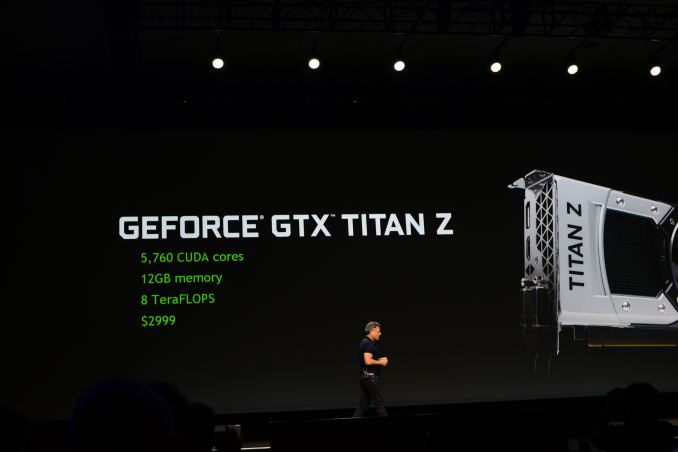NVIDIA Announces GeForce GTX Titan Z: Dual-GPU GK110 For $3000
by Ryan Smith on March 25, 2014 5:10 PM EST
Today at GTC NVIDIA announced their next GTX Titan family card. Dubbed the GTX Titan Z (no idea yet on why it’s Z), the card is NVIDIA's obligatory entry into the dual-GPU/single-card market, finally bringing NVIDIA’s flagship GK110 GPU into a dual-GPU desktop/workstation product.
While NVIDIA has not released the complete details about the product – in particular we don’t know precise clockspeeds or TDPs – we have been given some information on core configuration, memory, pricing, and availability.
| GTX Titan Z | GTX Titan Black | GTX 780 Ti | GTX Titan | |
| Stream Processors | 2 x 2880 | 2880 | 2880 | 2688 |
| Texture Units | 2 x 240 | 240 | 240 | 224 |
| ROPs | 2 x 48 | 48 | 48 | 48 |
| Core Clock | 700MHz? | 889MHz | 875MHz | 837MHz |
| Boost Clock | ? | 980MHz | 928MHz | 876MHz |
| Memory Clock | 7GHz GDDR5 | 7GHz GDDR5 | 7GHz GDDR5 | 6GHz GDDR5 |
| Memory Bus Width | 2 x 384-bit | 384-bit | 384-bit | 384-bit |
| VRAM | 2 x 6GB | 6GB | 3GB | 6GB |
| FP64 | 1/3 FP32 | 1/3 FP32 | 1/24 FP32 | 1/3 FP32 |
| TDP | ? | 250W | 250W | 250W |
| Transistor Count | 2 x 7.1B | 7.1B | 7.1B | 7.1B |
| Manufacturing Process | TSMC 28nm | TSMC 28nm | TSMC 28nm | TSMC 28nm |
| Launch Date | 04/XX/14 | 02/18/14 | 11/07/13 | 02/21/13 |
| Launch Price | $2999 | $999 | $699 | $999 |
In brief, the GTX Titan Z is a pair of fully enabled GK110 GPUs. NVIDIA isn’t cutting any SMXes or ROP partitions to bring down power consumption, so each half of the card is equivalent to a GTX 780 Ti or GTX Titan Black, operating at whatever (presumably lower) clockspeeds NVIDIA has picked. And although we don’t have precise clockspeeds, NVIDIA has quoted the card as having 8 TFLOPS of FP32 performance, which would put the GPU clockspeed at around 700MHz, nearly 200MHz below GTX Titan Black’s base clock (to say nothing of boost clocks).
On the memory front GTX Titan Z is configured with 12GB of VRAM, 6GB per GPU. NVIDIA’s consumer arm has also released the memory clockspeed specifications, telling us that the card won’t be making any compromises there, operating at the same 7GHz memory clockspeed of the GTX Titan Black. This being something of a big accomplishment given the minimal routing space a dual-GPU card provides.
In terms of build the GTX Titan Z shares a lot of similarities to NVIDIA’s previous generation dual-GPU card, the GTX 690. NVIDIA is keeping the split blower design, with a single axial fan pushing out air via both the front and the back of the card, essentially exhausting half the hot air and sending the other half back into the case. We haven’t had any hands-on time with the card, but NVIDIA is clearly staying with the black metal styling of the GTX Titan Black.
The other major unknown right now is power consumption. GTX Titan Black is rated for 250W, and meanwhile NVIDIA was able to get a pair of roughly 200W GTX 680s into the 300W GTX 690 (with reduced clockspeeds). So it’s not implausible that GTX Titan Z is a 375W card, but we’ll have to wait and see.
But perhaps the biggest shock will be price. The GTX Titan series has already straddled the prosumer line with its $1000/GPU pricing; GTX Titan was by far the fastest thing on the gaming market in the winter of 2013, while GTX Titan Black is a bit more professional-leaning due to the existence of the GTX 780 Ti. With GTX Titan Z, NVIDIA will be asking for a cool $3000 for the card, or three-times the price of a GTX Titan Black.
It goes without saying then that GTX Titan Z is aimed at an even more limited audience than the GTX Titan and GTX Titan Black. To be sure, NVIDIA is still targeting both gamers and compute users with this card, and since it is a GeForce card it will use the standard GeForce driver stack, but the $3000 price tag is much more within the realm of compute users than gamers. For gamers this may as well be a specialty card, like an Asus ARES.
Now for compute users this will still be an expensive card, but potentially very captivating. Per FLOP GTX Titan Black is still a better deal, but with compute users there is a far greater emphasis on density. Meanwhile the GTX Titan brand has by all accounts been a success for NVIDIA, selling more cards to compute users than they had ever expected, so a product like GTX Titan Z is more directly targeted at those users. I have no doubt that there are compute users who will be happy with it – like the original GTX Titan it’s far cheaper per FP64 FLOP than any Tesla card, maintaining its “budget compute” status – but I do wonder if part of the $3000 pricing is in reaction to GTX Titan undercutting Tesla sales.
Anyhow, we should have more details next month. NVIDIA tells us that they’re expecting to launch the card in April, so we would expect to hear more about it in the next few weeks.
Source: NVIDIA











64 Comments
View All Comments
Mondozai - Tuesday, March 25, 2014 - link
This is a worthless card for gamers.inb4: BUT IT IS NOT FOR GAMING.
Well, read their blog. They are selling it like a gaming card. Their CEO merely tailor-made the presentation on GTC to fit the crowd. On their blog it says it is "engineered for gaming".
Nvidia is beating new records of greed.
nathanddrews - Tuesday, March 25, 2014 - link
"Greed" is a word thrown around too lightly. People said the same thing about Titan v1.0, but people still flocked to buy SLI Titan setups. The Titan Z will likely be just as successful.chaosbloodterfly - Tuesday, March 25, 2014 - link
Pretty much. It's a corporation's job to maximize profit. Do people think nVidia makes cards for charity or something?Nagorak - Tuesday, March 25, 2014 - link
I'm not sure the word "flocked" is appropriate. Even if more people bought Titan than expected, it's still a very, very miniscule amount of people out of the entire group of graphics card purchasers.nathanddrews - Wednesday, March 26, 2014 - link
OK then, the niche market flocked to it... which is true of every high-end product. The sales were strong enough to justify Titan Black and now Titan Z at even higher price points. If I had a mITX setup and 3K to throw around, I would already have a Titan Z preorder.ddriver - Saturday, March 29, 2014 - link
And now, a limited time offer, you can get TWO titans at the price of THREE!WithoutWeakness - Tuesday, March 25, 2014 - link
It's a halo product, just as the first Titan was a halo product. People will buy it. There are people who have a virtually unlimited budget for their computers and they will buy this card. I would buy a Titan Z if $3K was a drop in the bucket to me; in fact I would buy two of them. The card being $3K is a little absurd but they're straddling the line between making as much as they can selling gamers a GeForce card while avoiding undercutting their Tesla compute card sales.This is also Kepler's last hurrah as the fastest desktop card before Maxwell rolls out. Nvidia is milking 28nm Kepler for everything they can because it's cheaper to manufacture than 20nm Maxwell. If they can charge top dollar for GPUs and still have people buy them then they will continue to do so. They ARE a company after all and their primary concern is increasing profit and share price.
beck2050 - Wednesday, March 26, 2014 - link
Exactly right. Its a halo product for people with bucks, and their plenty of those around. Reading the hate mail is just sour grapes, It's like sniveling about how expensive a Ferrari is because a Chevy Nova will get you there just as well.Yojimbo - Tuesday, March 25, 2014 - link
"greed"? give me a break. if you think it's overpriced don't buy it.tim851 - Thursday, March 27, 2014 - link
This.nVidia had a net income of 500-something million dollars last year. Or as Apple calls it: a bad week.
But yeah, so greedy.